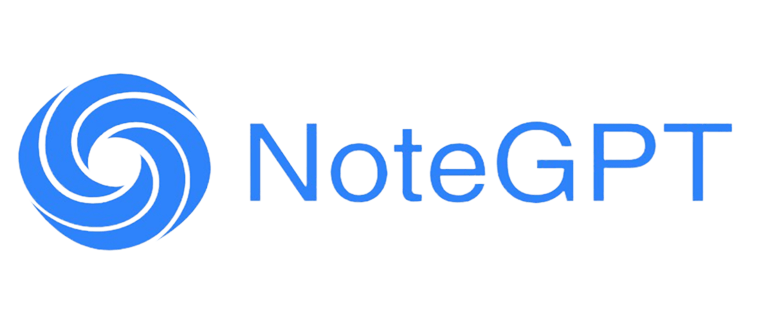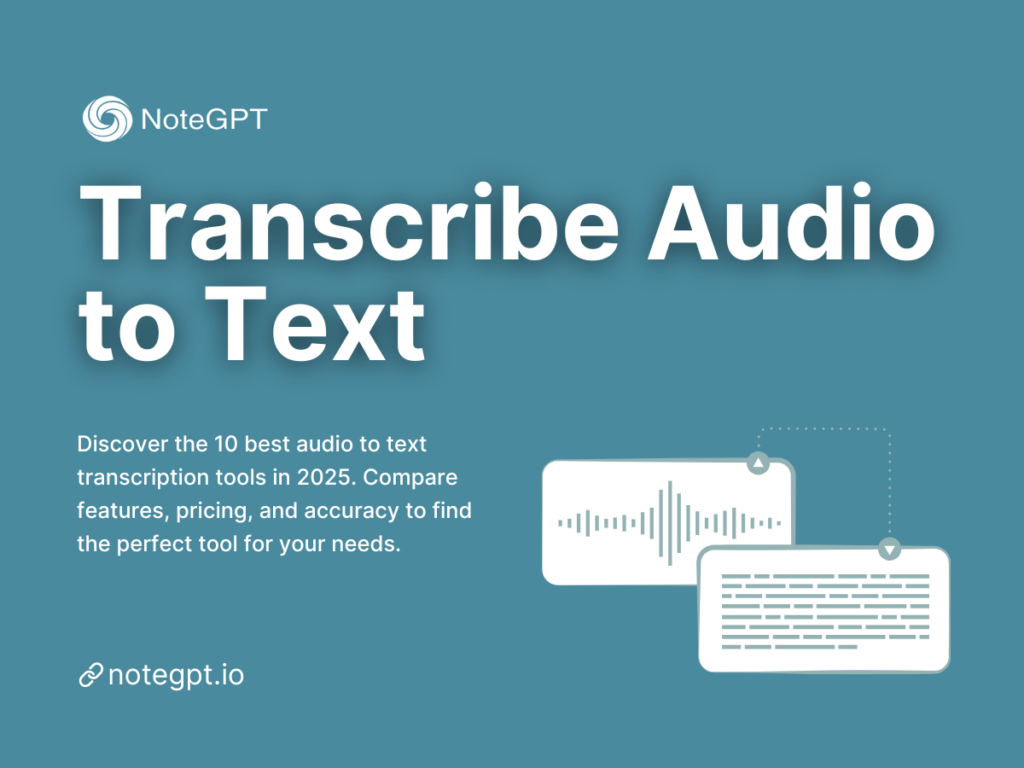In 2025, if you’re still typing out meeting notes manually or rewinding your podcast five times to catch a quote—you’re doing it wrong. We’re living in the golden age of AI transcription, where you can transcribe audio to text in seconds with near-perfect accuracy. From virtual classrooms to corporate boardrooms, the demand for converting audio into structured, searchable text has never been higher.
But with so many tools out there claiming to be the “best audio to text transcription app,” how do you separate the signal from the noise? We’ve done the heavy lifting: tested, compared, and reviewed the most powerful transcription services so you don’t have to.
Welcome to the ultimate guide to the top 10 best tools to transcribe audio to text in 2025.
Why Accurate Audio to Text Transcription Matters in 2025
Think transcription is just for courtrooms or journalists? Think again. In today’s fast-moving, content-saturated world, accurate audio transcription powers everything from video captions and SEO optimization to legal compliance and educational accessibility.
Here’s why it matters:
- Searchability: Let’s face it—nobody wants to scrub through a 90-minute meeting recording. Transcribing audio to text makes every word instantly searchable.
- Repurposing content: That podcast episode? Now it’s also a blog post, a newsletter blurb, and an SEO goldmine.
- Inclusion and accessibility: Providing transcripts supports users with hearing impairments and ensures content is compliant with accessibility standards.
- Data extraction: Transcripts can feed into AI summarizers, knowledge bases, or data analytics platforms.
In short: if your content lives in audio, then transcription is how it learns to speak text.
How to Choose the Right Tool to Transcribe Audio to Text
Not all transcription tools are created equal. Depending on your goals—whether you're a student, marketer, content creator, or enterprise user—you’ll want different capabilities from your tool. Here’s what to evaluate:
Supported File Formats: MP3, WAV, MP4, and More
Make sure your tool accepts a wide range of input formats. Most users need transcription from common file types like MP3, WAV, M4A, and even video files like MP4. The broader the file support, the smoother your workflow.
AI vs. Human vs. Hybrid Transcription Services
- AI transcription: Fast, cheap, increasingly accurate—but still not 100% perfect.
- Human transcription: Slower and pricier, but ideal for complex or noisy audio.
- Hybrid models: Combine the speed of AI with human proofreading. Great for professional-grade transcription.
Language Support and Accuracy
If you need to transcribe audio to text in multiple languages, be sure the platform supports your target language and has solid accuracy. Some tools support over 100 languages, while others specialize in high-quality English-only transcription.
Features: Timestamps, Speaker Labels, Punctuation
- Timestamps: Time markers that help navigate long audio.
- Speaker labels: Distinguish who’s saying what in multi-speaker environments.
- Automatic punctuation: Essential for readability—no one wants a stream of consciousness transcript.
- Search & edit: Some tools let you edit directly in the transcript, perfect for quick fixes.
Team Collaboration, Export Options, and API Access
If you’re working in a team or using the tool as part of a larger content pipeline, look for:
- Collaboration tools: Comments, edits, and shareable links.
- Export formats: TXT, DOCX, PDF, SRT, and more.
- API integrations: Essential for automated workflows.
Top 10 Best Transcribe Audio to Text Tools in 2025
We tested dozens of transcription services to bring you the top 10. Rankings are based on transcription accuracy, speed, pricing, usability, and advanced features.
1. NoteGPT – AI-Powered Audio Transcription Redefined
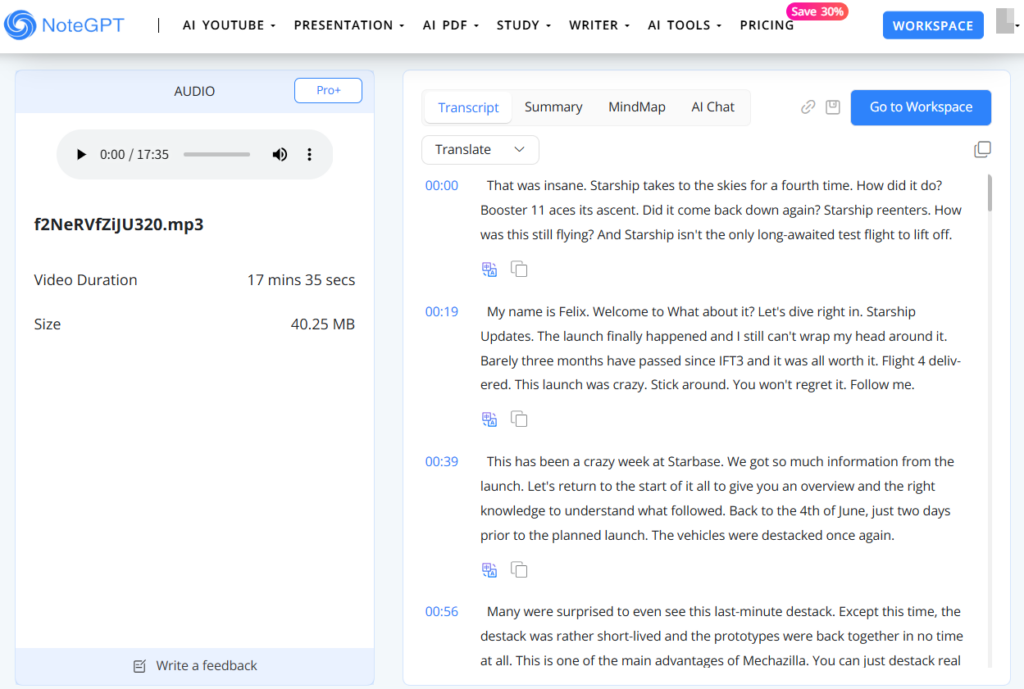
Best for: All-in-one transcription, summarization, and AI interaction
If transcription tools had IQ scores, NoteGPT would be at the top of the class. This is more than a platform to transcribe audio to text—it’s a full-blown AI assistant that turns audio files into structured knowledge.
Why it’s #1 in 2025:
- Transcribes audio to text with GPT-grade accuracy in seconds
- Supports MP3, WAV, MP4, YouTube links, and more
- Includes AI summarization and semantic Q&A on your transcript
- Supports dozens of languages and accents
- Exports to multiple formats (PDF, DOCX, plain text)
What really sets NoteGPT apart is its ability to interact with transcripts. You can literally chat with your content: ask for summaries, extract keywords, or request action items from a meeting. It’s like having ChatGPT embedded in your transcription.
Whether you’re transcribing an interview, turning a podcast into a blog, or analyzing a client meeting—NoteGPT is the smartest way to go from audio to insight.
2. Otter.ai – Real-Time Meeting Transcriber
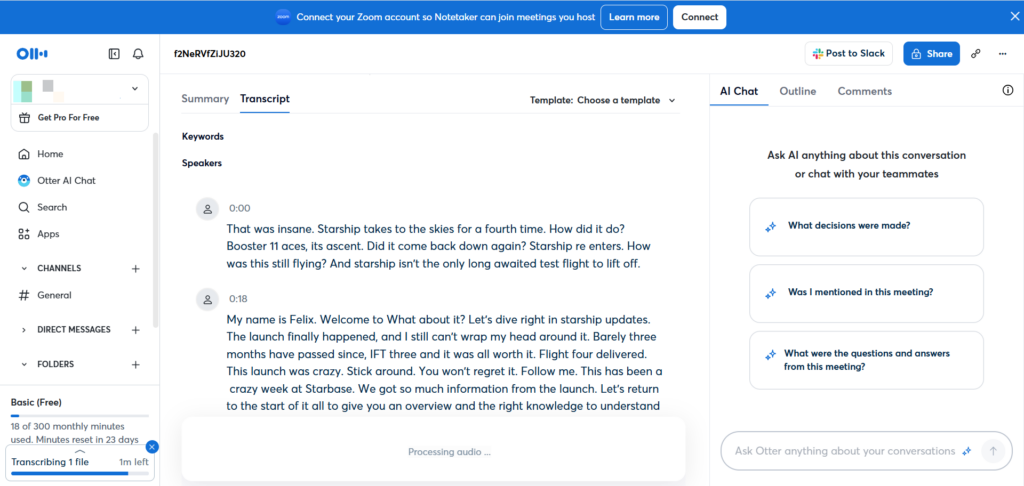
Best for: Business teams and remote meetings
Otter.ai is the workhorse of corporate transcription. Known for its real-time meeting transcription and integrations with Zoom, Microsoft Teams, and Google Meet, Otter turns your spoken conversations into searchable, sharable records—live.
Features to love:
- Live transcription during virtual meetings
- Automatically joins meetings and transcribes them
- Speaker ID and keyword summaries
- Syncs with calendar events for easy scheduling
Otter is especially popular among professionals who need to transcribe audio to text on the fly, without uploading files manually. If you're juggling multiple calls a day, Otter is the silent assistant you didn’t know you needed.
3. Descript – Edit Audio by Editing Text
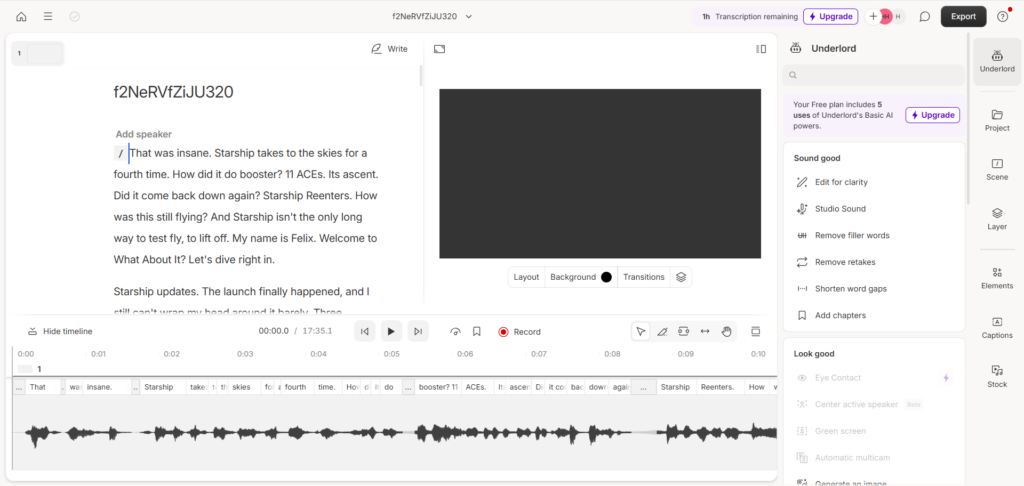
Best for: Podcasters, video editors, and creators
Descript blurs the line between transcription tool and media editor. You upload an audio or video file, and Descript transcribes it—but then you can edit the audio by editing the text.
Standout capabilities:
- Overdub (voice cloning)
- Multi-track transcription
- Automatic filler word removal
- Screen recording and video editing
Descript is perfect for creators who want to streamline their post-production process. Need to edit a podcast and remove “um” 73 times? Descript makes that easy—and hilarious.
4. Rev – Human-Verified Transcription Accuracy
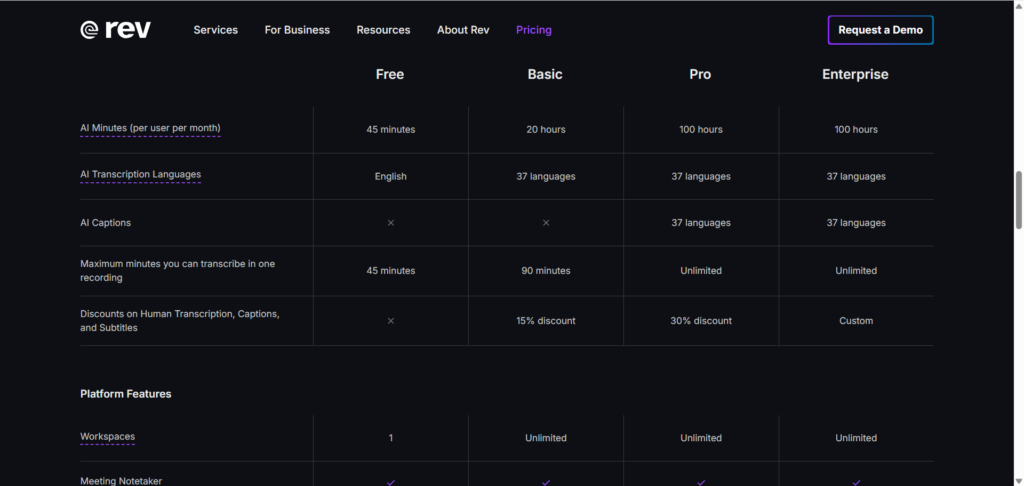
Best for: Legal, media, and academic professionals
If your top priority is accuracy and you’re willing to pay for it, Rev is your go-to. Rev offers both AI and human transcription options, with human-edited transcripts boasting 99% accuracy.
Why choose Rev:
- Human transcription: $1.50 per minute
- AI transcription: $0.25 per minute
- Fast turnaround: Under 12 hours for human, minutes for AI
- Available in multiple languages
Rev is trusted by journalists, lawyers, and researchers who need pristine, accurate transcripts of critical conversations. You won’t find flashy AI features, but you will find dependable precision.
5. Whisper – Open-Source & Multilingual
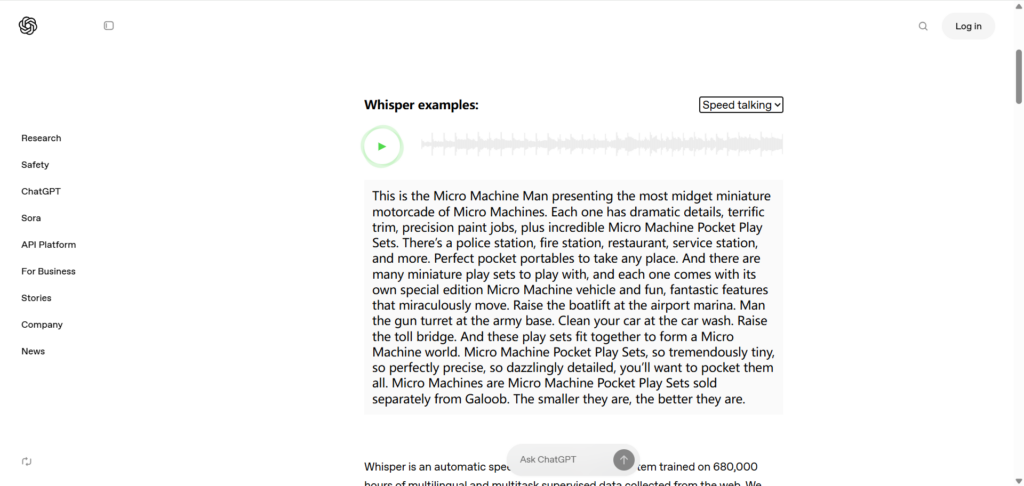
Best for: Developers, researchers, and multilingual users
Whisper is OpenAI’s contribution to the transcription landscape. It’s open-source, multilingual, and remarkably accurate—especially for a free tool.
Key highlights:
- Supports 50+ languages
- Strong performance with accented and noisy audio
- Available as a Python package or via third-party integrations
- Ideal for developers building transcription into apps
While Whisper isn’t a plug-and-play solution for the average user, it’s a powerful engine behind many transcription tools you already know and love. If you’re tech-savvy and want to transcribe audio to text at scale, Whisper is a no-brainer.
6. Trint – Transcribe & Collaborate in Teams
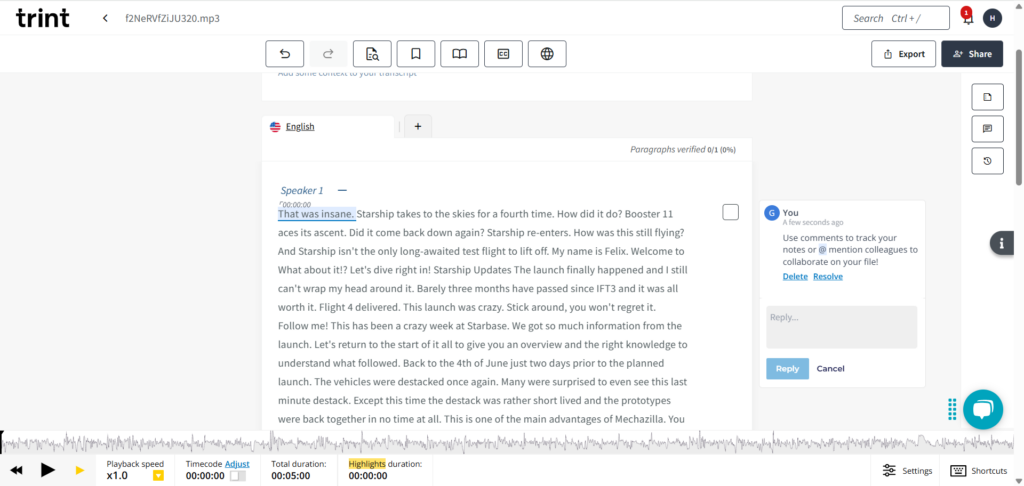
Best for: Enterprise teams and collaborative editing
Trint is where AI transcription meets team productivity. It’s built for professionals who not only need to transcribe audio to text quickly, but also collaborate around the content.
Why Trint stands out:
- Built-in transcript editor and highlighter
- Shareable links for team reviews
- Automated keyword extraction and summaries
- Supports video and audio file formats
Trint works great for agencies, marketing teams, and video producers who deal with large volumes of content and need to tag, review, and publish fast. It’s more than just a transcription tool—it’s a content pipeline.
7. Sonix – Best for Multilingual Transcription
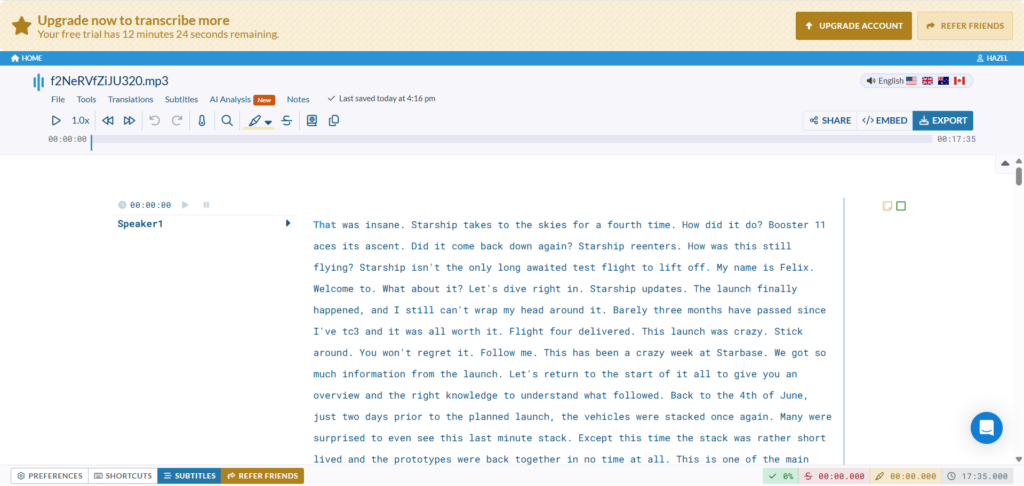
Best for: Global teams and international content
If you need to transcribe audio to text in multiple languages with precision, Sonix delivers. With support for over 40 languages and dialects, it’s one of the most language-diverse tools on the market.
Why multilingual users love Sonix:
- Excellent language recognition
- Audio-to-text timestamping and speaker separation
- Translation and subtitling tools
- Secure cloud-based platform
Sonix also offers automatic subtitles for videos, making it a favorite among global YouTubers and marketing teams targeting multiple regions.
8. Temi – Budget-Friendly AI Transcription
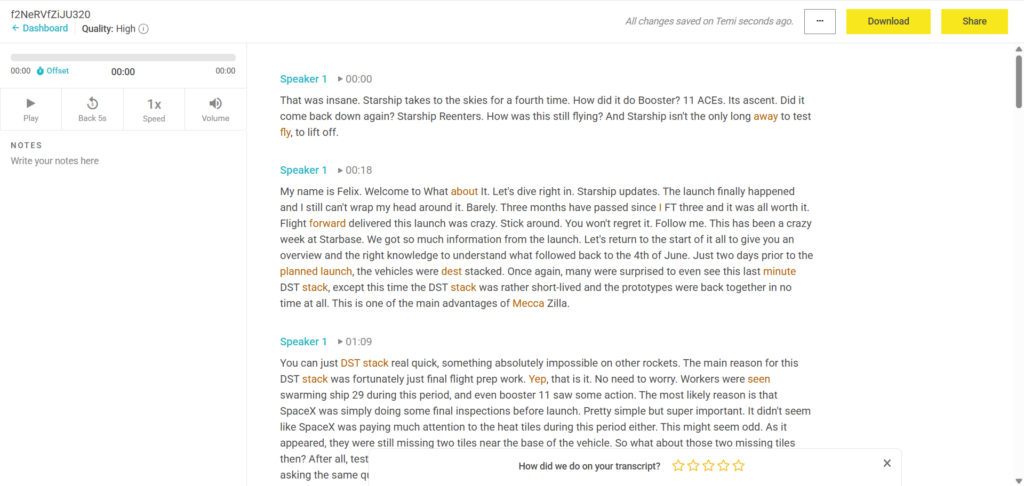
Best for: Solopreneurs, students, and light users
Temi is perfect for users who want fast, affordable transcription with reasonable accuracy. It uses speech recognition technology similar to Rev’s AI, but at a lower cost.
What to expect:
- $0.25 per minute pricing
- 5-minute free trial
- Easy-to-use interface with timestamped transcripts
- Export to TXT, DOCX, PDF
Temi doesn’t have advanced features or flashy tools, but if your main goal is to transcribe audio to text without spending a fortune, it’s one of the most accessible platforms out there.
9. Happy Scribe – Subtitles and Translation Friendly
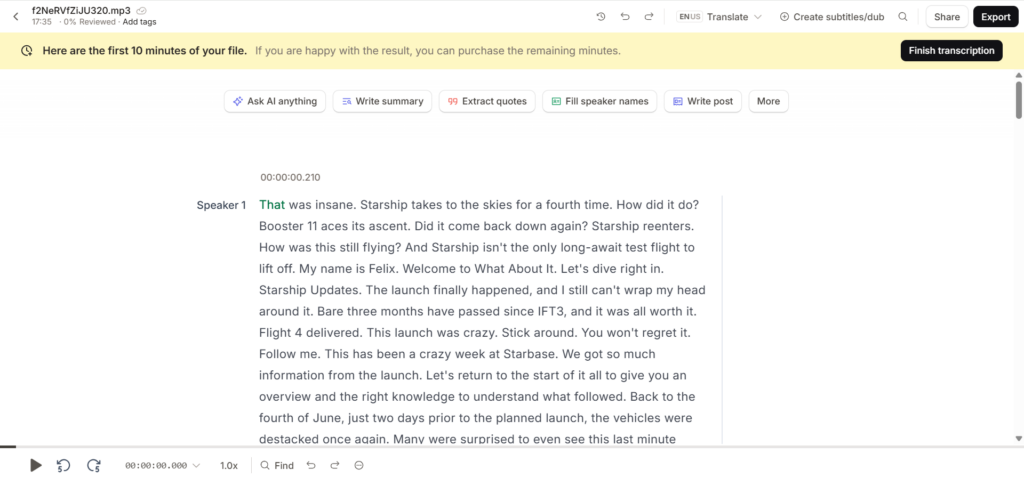
Best for: Video creators, filmmakers, and educators
Happy Scribe makes it easy to transcribe audio to text and generate subtitles or translations all in one workflow. It’s a favorite among documentary creators, YouTubers, and academics.
Why it’s unique:
- Subtitle editor with custom timing
- Multiple export formats: SRT, VTT, TXT
- Translation into 60+ languages
- Option for professional (human) transcription
Happy Scribe is especially good if your work involves making content more accessible or multilingual—and it’s one of the few platforms where you can toggle between subtitles and transcripts seamlessly.
10. Scribie – Secure & Confidential Transcription
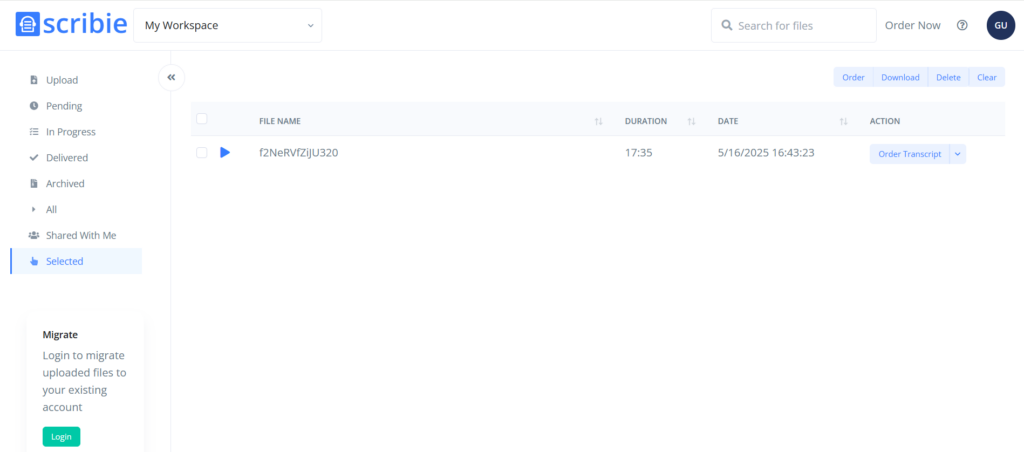
Best for: Confidential recordings and sensitive content
Scribie may not have the brand flash of others, but it’s a go-to when privacy matters most. Known for its secure systems and human review process, Scribie supports both AI and manual transcription.
Notable strengths:
- End-to-end encryption
- Affordable pricing with a free trial
- Timestamps and speaker tracking included
- Supports noisy and accented audio well
If you're in healthcare, law, or financial services and need to transcribe audio to text securely, Scribie is a trustworthy option.
Comparison Table – Transcribe Audio to Text Tools at a Glance
| Tool | AI or Human | Languages Supported | Key Features | Best For |
| NoteGPT | AI | 40+ | AI Q&A, summaries, doc export | All-in-one transcription + AI |
| Otter.ai | AI | English + variants | Real-time, live meeting transcription | Business, remote teams |
| Descript | AI | English | Audio editing via text, voice cloning | Creators, podcasters |
| Rev | Hybrid | 15+ | Human-verification, ultra accuracy | Journalists, legal, academic |
| Whisper | AI (OSS) | 50+ | Open source, high-quality multilingual | Devs, researchers |
| Trint | AI | 30+ | Collaboration tools, editing, tagging | Teams, marketing |
| Sonix | AI | 40+ | Transcription + translation + subtitles | Multilingual professionals |
| Temi | AI | English | Simple, cheap, timestamped transcripts | Budget users, students |
| Happy Scribe | Hybrid | 60+ | Subtitle + translation, subtitle editor | Filmmakers, educators |
| Scribie | Hybrid | 30+ | Secure, confidential, human QA | Privacy-sensitive transcription |
Use Cases – Who Needs to Transcribe Audio to Text?
1. Business Meetings & Internal Documentation
Whether it's quarterly reviews or daily stand-ups, transcribing team calls improves transparency and helps teams stay aligned. Meeting recordings become searchable records. No more “Who said what?” confusion.
2. Education: Lectures and Study Notes
Students and educators are using transcription tools to turn spoken lectures into study guides. International students benefit especially from multilingual transcription, and professors can archive entire semesters effortlessly.
3. Content Creation: Podcasts, YouTube, TikTok
Transcripts help creators repurpose spoken content into blogs, social posts, and captions. They also boost discoverability on Google and improve accessibility—a win-win.
4. Journalism & Interviews
Journalists live by the clock. Transcribing interviews manually is a time-killer. These tools speed up the writing process and provide accurate quotes—especially when using human-reviewed services.
5. Legal, Healthcare, and Professional Sectors
In law and healthcare, documentation is everything. Transcription ensures compliance, improves client communication, and creates a searchable archive of case notes or consultations—all while maintaining confidentiality.
FAQ – Everything About Audio Transcription in 2025
Q1: Can I transcribe audio to text for free? Yes. Tools like NoteGPT and Whisper offer free tiers or open-source options. However, accuracy and features may vary.
Q2: What's the difference between AI and human transcription? AI is faster and cheaper, while human transcription is slower but more accurate—especially for noisy or complex audio.
Q3: Can I transcribe YouTube videos directly? Some tools (like NoteGPT) allow URL uploads or auto-extraction from YouTube. Others may require downloading the audio first.
Q4: Is it safe to upload confidential audio? Yes—if you choose tools like Scribie or Rev that offer encrypted, private transcription services with secure storage.
Q5: How accurate is AI transcription in 2025? Many AI tools now reach 90–95% accuracy on clear audio. With speaker labeling and context awareness improving, they’re becoming reliable even in professional environments.
Conclusion
From real-time business transcription to AI-powered content summarization, the way we transcribe audio to text has evolved dramatically in 2025. Whether you're a content creator looking to save time, a student aiming to study smarter, or a professional needing airtight documentation, there's a tool tailored for your workflow.
But if you want a platform that goes beyond simple transcription—offering interaction, insights, and intelligence—NoteGPT stands out as the most innovative, versatile tool of the year.
No more rewinding, no more typing. The future of transcription is here, and it listens well.
